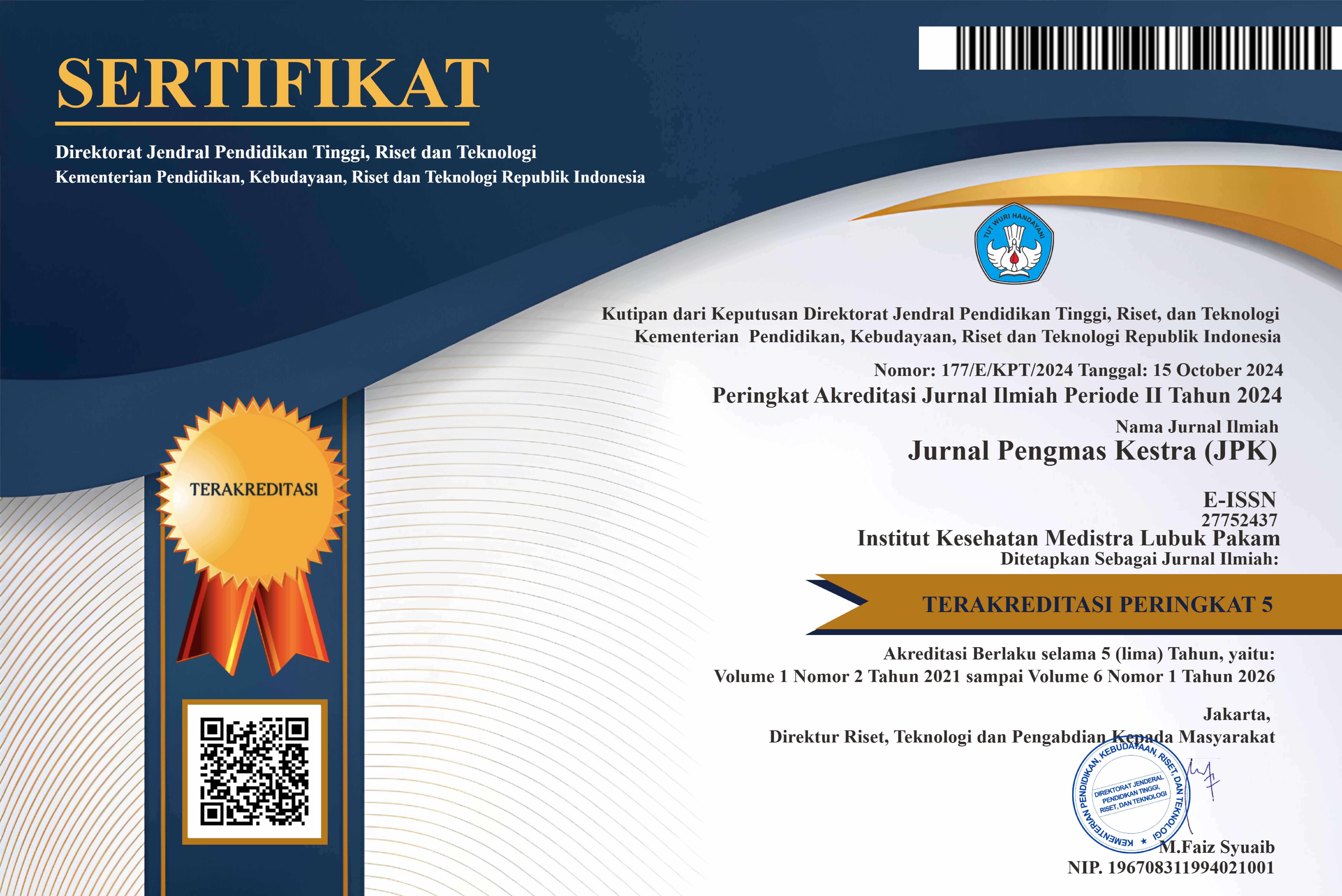Implementation of Dysmenorhore Exercises in Reducing Menstrual Pain Toward Adolescent Women At Lubuk Pakam I Sub-District
DOI:
https://doi.org/10.35451/jpk.v3i2.2001Keywords:
Menstrual Pain, Knowledge, Teenage girl, Dysmenorrhea ExerciseAbstract
Adolescence is a period when a person experiences a transition from child to adult which is usually marked by physical and mental changes. One of the changes that occurs in young women is experiencing menstruation. Menstruation usually causes pain (dysmenorrhea) which can interfere with daily activities. Dysmenorrhea exercise is one solution that can reduce menstrual pain. This exercise is a relaxation technique that can produce endophrin hormones which act as a natural sedative. Endofrins create a feeling of comfort in the nerves so they can suppress pain. The PkM activity was held in the Lubuk Pakam sub-district, where the PkM participants were young women who were determined randomly, namely 15 people. Implementation of PkM is carried out using several methods, namely delivery of material, demonstrations, discussions and questions and answers. Before implementing PkM, participants were given a pre-test to measure their initial level of knowledge. Then, during the activity evaluation, a post-test will be given so that the success of this PkM activity can be assessed. The PkM results show that menstrual pain in young women can generally interfere with activities. Dysmenorrhea exercises have been proven to reduce menstrual pain. The results of the PkM implementation showed that there was an increase in the knowledge and abilities of PkM participants regarding dysmenorrhea exercises in dealing with menstrual pain with a percentage of 100%. The average pre-test knowledge score for PkM participants was 50. However, after implementation, the average post-test knowledge score was 90. The ability of PkM participants also increased because they were able to do exercises independently.
References
Astuti, M. T., & Sukesi, N. (2017). Efektifitas Efektifitas Teknik Relaksasi Dalam Untuk Menurunkan Skala Nyeri Pada Pasien Post Oprasi Sectio Caesarea. Jurnal Manajemen Asuhan Keperawatan.
Ismarozi, Desti, Dkk. (2015). Efektivitas Senam Dismenore Terhadap Penanganan Nyeri Haid Primer Pada Remaja. Unri, 2, 1.
Kumalasari, & Fitri, M. L. (2016). Efektivitas Senam Dismenore Sebagai Terapi Menurunkan Tingkat Nyeri Haid.
Latoha, L. M. (2018). Pengaruh Teknik Relaksasi Nafas Dalam Terhadap Nyeri Haid (Dismenore) Pada Remaja Pantai Asuhan Samarinda. Poltekes Kemenkes Kalimantan Timur.
Lestari, N. S. (2018). Pengaruh Dismenorea Pada Remaja. Seminar Nasional FMIPA UNDIKSHA III tahun 2013, 323.
Manuaba. (2016). Ilmu Kebidanan Buku Ajar Obstetri dan Ginekologi. Bali: Graha Cipta.
Marlinda, R. dan Purwaningsih, P. (2013). Pengaruh Senam Dismenore.
Nuraeni. 2017. Pengaruh Senam Dismenore Terhadap Penurunan Nyeri Pada Remaja Putri SMK 1 Tapango Kecamatan Tapango Kabupaten Polewali Mandar. Jurnal Ilmiah Bidan, Vol. II, No.1, 2017.
Nurjanah, I., & Iswari, M. F. (2019). Pengaruh senam dismenore terhadap nyeri menstruasi pada mahasiswi asrama STIKes Muhammaiyah Palembang. Jurnal Syifa' Medika 10(1), 3244-3252.
Nursalam, 2020. Metodologi Penelitian Ilmu Keperawatan. Pendekatan Praktis. Jakarta: Selemba Medika.
Saputri, IN dan Pasaribu YYAM. 2023. The Effect of Dismenorerage Exercise on Dysmenorerage in Adolescent Women in Bah Jambi Private Junior High School. Jurnal Keperawatan dan Fisioterapi (JKF) Vol. 6 No. 1 (2023).
Downloads
Published
Issue
Section
License
Copyright (c) 2023 Ika Nur Saputri, Irma Nurianti, Yoma Yopa Malem Ate Pasaribu

This work is licensed under a Creative Commons Attribution 4.0 International License.
Copyright in each article is the property of the Author.




















